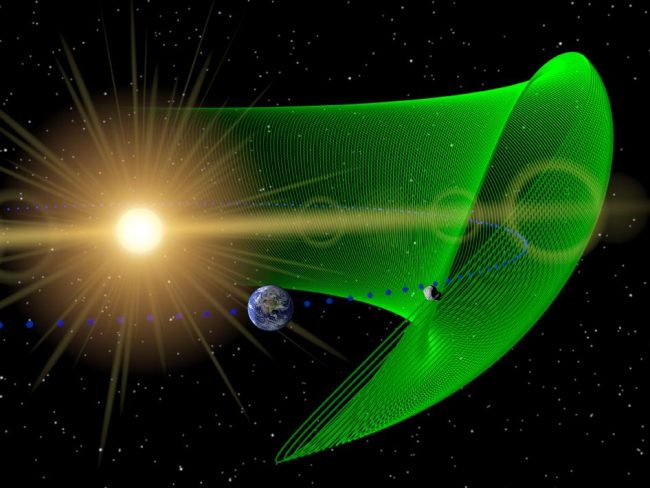
Earth’s number of known Trojan asteroid might take a leap up (or not) in February 2017, when the OSIRIS-REx spacecraft – on its two-year outbound journey to asteroid Bennu – passes near Earth’s gravitationally stable L-4 point. This point lies 60 degrees ahead of us in orbit. Asteroids should, in theory, gather near there. Between February 9 and 20, the NASA spacecraft – whose mission team is at University of Arizona (UA) – will activate its onboard camera suite and search for Earth-Trojan asteroids.
The L-4 point is a Lagrangian point in the Earth-sun system. It’s sometimes referred to as a gravity well. Objects caught in orbit around L-4 aren’t pulled closer to either the sun or the Earth. Instead, they maintain their configuration – near one tip of an equilateral triangle with the Earth and sun – always moving ahead of Earth in orbit.
Space mission planner take full advantage of the gravitationally stable Lagrangian points by placing spacecraft at them, or in orbit around them.

And nature loves these regions in space, too. Natural objects – interplanetary dust, small moons, asteroids – have been found at such places. The first asteroids at Lagrangian points were discovered in Jupiter’s orbit, at gravitationally stable points L4 and L5 in the Jupiter-sun system, 60 degrees ahead of and behind Jupiter. They were named Trojan asteroids for the warriors of the Trojan war in Greek mythology.
Six planets in our solar system are known, so far, to have Trojan asteroids. Giant Jupiter with its powerful gravity has the biggest number found so far, more than 6,000. Meanwhile, Venus is known to have one Trojan, Earth one, Mars seven, Uranus one and Neptune 18. We will surely find more.
Earth’s one Trojan to date is 2010 TK7, found in October 2010 by NEOWISE.


In theory, there should be multiple asteroids collected near Earth’s Lagrangian points. That’s why scientists with the OSIRIS-REx mission want to search for them. Their statement explained:
Over 12 days, the OSIRIS-REx Earth-Trojan asteroid search will employ the spacecraft’s MapCam imager to methodically scan the space where Earth Trojans are expected to exist. MapCam is part of the OSIRIS-REx Camera Suite, or OCAMS, which was designed and built by researchers at the UA’s Lunar and Planetary Laboratory.
Many of the campaign’s observations will closely resemble MapCam’s planned activities during its upcoming search for small rocks orbiting asteroid Bennu. While the likelihood of finding such small rocks around Bennu is low, the Trojan asteroid search serves as an early rehearsal for this critical safety check, as well as for the mission’s primary science operations.
Dante Lauretta, OSIRIS-REx principal investigator and professor of planetary science at the Lunar and Planetary Laboratory at University of Arizona, commented in a statement:
The Earth-Trojan asteroid search provides a substantial advantage to the OSIRIS-REx mission. Not only do we have the opportunity to discover new members of an asteroid class, but more importantly, we are practicing critical mission operations in advance of our arrival at Bennu, which ultimately reduces mission risk.
The OSIRIS-REx spacecraft is currently on a seven-year mission to rendezvous with, study and return a sample of Bennu to Earth. Click here to learn where OSIRIS-REx is now. The idea of searching for Earth-Trojan asteroids isn’t the primary mission, but it’s a great add-on. Because they’re relatively near Earth, Earth-Trojan asteroids might be good places for future space mining.
By the way, because Trojan asteroids stay 60 degrees ahead of or behind Earth in orbit, there’s no danger they’ll collide with us.

Bottom line: In February 2017, the OSIRIS-REx spacecraft will search for Earth-Trojan asteroids in the vicinity of Earth’s L-4 point while on its outbound journey to the asteroid Bennu.











